Loan Manager
Manage and analyze all the operation of your loans.
In the Loan Manager section, you will find 5 sections at the top: Loan Requests, Loans, Payments, Pre-Payments and Transactions which can be accessed.
Loan Requests
In the Loan Requests section, you will find the total number of requests to date. In this sub-section are all loan requests, made by the user, completed or not. It is possible that their definition may vary according to the business rules of each project.
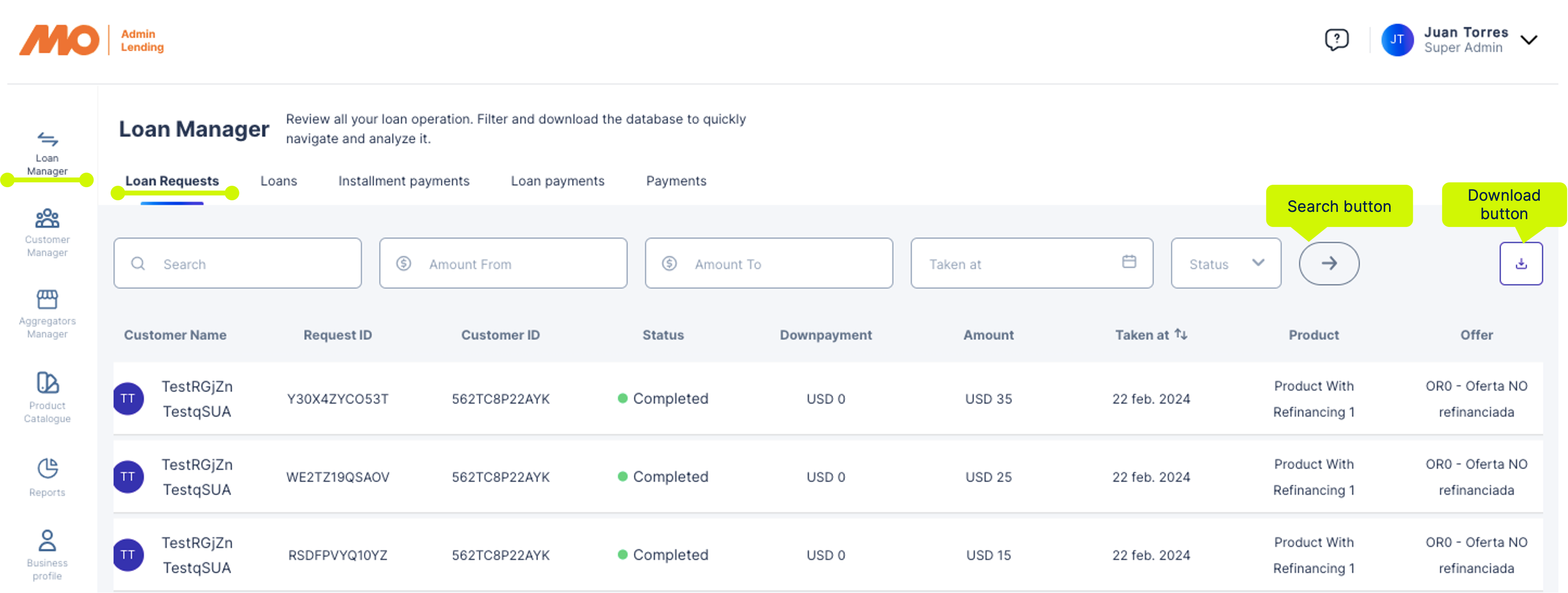
At the top you will find some filters that will allow you to make a better search in the list of applications.
- Filter Search: Enter the client ID, request ID or client name to find your information in the list.
- Filter Amount from-to: enter a minimum and/or maximum amount to find all requests for amounts belonging to this range.
- Filter Taken at: select a specific date or period (days, weeks or months) to find the requests made on these dates. The filter has a drop-down to facilitate the search.
- Status filter: select the status to find the requests belonging to this group. The filter has a drop-down to facilitate the search.
The user can make use of one or more filters at a time. Once you have selected the filters you want to work with, click on the "Search" button to start the search.
The Taken at filter has a drop-down to facilitate the search. Select the period you wish to search (manually in the calendar or via the pre-determined options), then click on the "Set Date" button to set the date.
The Status filter also has a drop-down. Click on the right arrow to display the status options and select the one you wish to search for. Rejected, Completed, and Pending.
The download button will allow you to download the information reflected in the list in CSV format. If there are active filters at the time of downloading, only the information corresponding to the active filters will be downloaded.

Download button
List fields:

The fields with arrows on the side allow you to organize the information in ascending or descending order.
- Customer Name: Name of the user captured in the onboarding process.
- Request ID: Unique identifier assigned to each credit request that has not yet been confirmed.
- Customer ID: Unique identifier assigned to each user who completed the onboarding process.
- Status: Status of a pre-loan, possible statuses are completed, pending, rejected or expired.
- Down payment: Amount that should have been paid by the user at the time of purchase, this amount is not part of the credit.
- Amount: Amount requested by the user
- Taken at: Date when the credit request is made
- Product: Name configured by the client when configuring the products.
- Offer: Name configured by the customer when configuring the offer.
Loans
In the Loans section you will find the total number of loans approved to date. A loan is a request that has already been approved and disbursed. It is possible that the definition may vary depending on the business rules of the project.

At the top you will find some filters that will allow you to make a better search.
- Filter Search: Enter the user or credit ID to find your information in the list.
- Filter Amount from-to: Enter a minimum and/or maximum amount to find all credits belonging to this range.
- Filter Taken at: Select a specific date or period (days, weeks or months) to find the requests made on these dates. The filter has a drop-down to facilitate the search.
- Filter Status: Select the status to find the requests belonging to this group. The filter has a drop-down to facilitate the search.
The user can make use of one or more filters at a time. Once you have selected the filters you want to work with, click on the "Search" button to start the search.
The Taken at filter has a drop-down to facilitate the search. Select the period you wish to search (manually in the calendar or via the pre-determined options), then click on the "Set Date" button to set the date.
The status filter also has a drop-down. Click on the right arrow to display the status options and select the one you want to search for. Active, Paid, Frozen.
The download button will allow you to download the information reflected in the list in CSV format. If there are active filters at the time of downloading, only the information corresponding to the active filters will be downloaded.

Download button
List fields:

The fields with arrows on the side allow you to organize the information in ascending or descending order.
- Loan ID: Unique number assigned to identify the loan requested by a user.
- Customer ID: Identifier of a user who completed the onboarding process.
- National ID: Identification number of the user's country of origin.
- Aggregator: Name of the client aggregator
- Aggregator ID: Unique numeric code of the aggregator client.
- Status: Status of a credit (Paid, active, frozen....)
- Amount: Capital amount requested by the user
- Taken at: Date on which the credit request was made.
- Product: Name configured by the client when creating a product.
- Offer: Offer name configured by the customer at the time of creating an offer
If you want more detailed information on the loans, you can click on any of the fields in the table. This will redirect you to the loan profile, where you can find more details.

In the Loan profile you will find two sections Loan Overview and Loan Details where you can view the following information:

If at the time of the query a user has a refinanced loan, the Refinanced Summary table will be displayed, otherwise this field will not be reflected.
Selecting the View original payment plan option in the loan profile will display a pop up with the original payment plan information of the initial loan, this pop up or table contains the original payment plan and payment schedule.
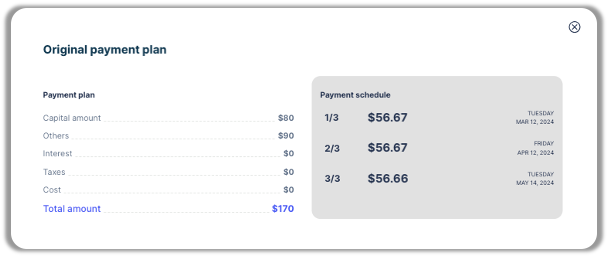
Installment Payments
The Installment Payments section refers to the total amount of installment payments made on a loan, here the user can find the total number of installment payments made on a loan to date, search filters, search and download button and information regarding the payments made.
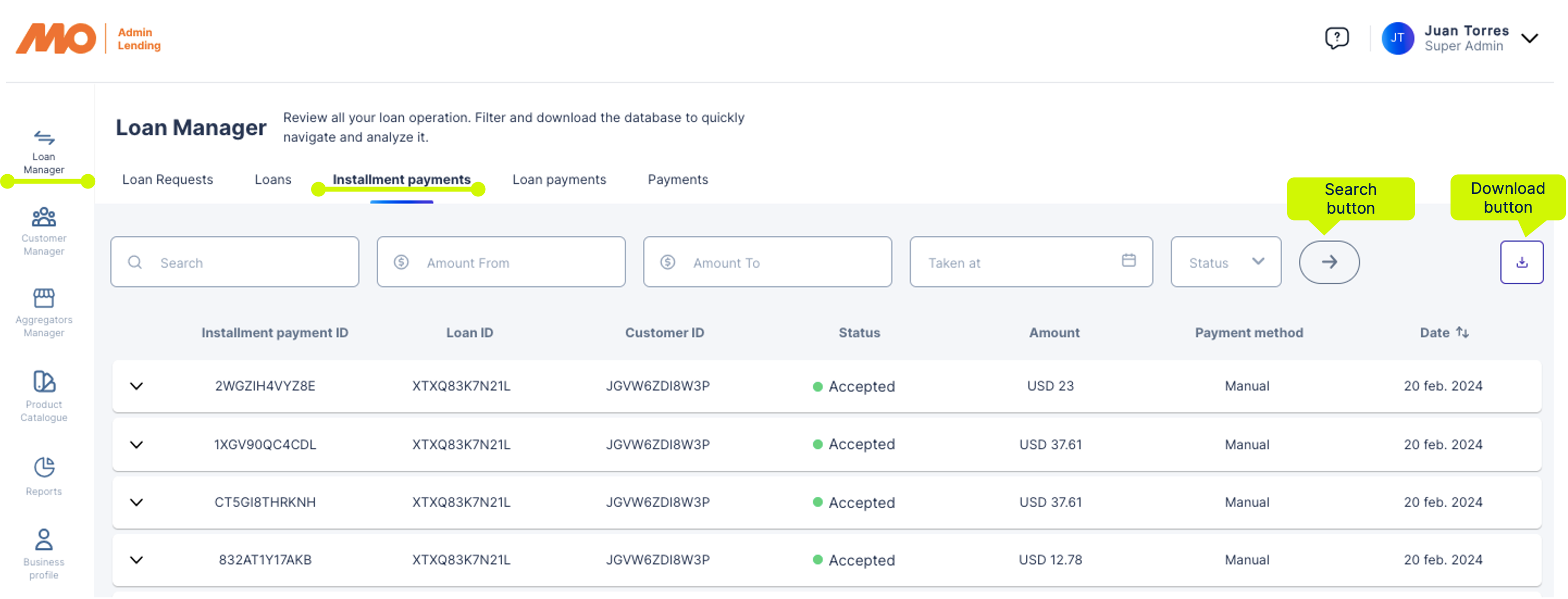
At the top you will find some filters that will allow you to make a better search.
- Search filter: enter the user or payment ID to find your information in the list.
- Amount from-to filter: enter a minimum and/or maximum amount to find all payments in this range.
- Filter Taken at: select a specific date or period (days, weeks or months) to find requests made on these dates. The filter has a drop-down to facilitate the search.
- Status filter: select the status to find payments belonging to this group. The filter has a drop-down to facilitate the search.
The user can make use of one or more filters at a time. Once you have selected the filters you want to work with, click on the "Search" button to start the search.
The Taken at filter has a drop-down to facilitate the search. Select the period you wish to search (manually in the calendar or via the preset options on the left), then click the "Set Date" button to select the date.
The Status filter also has a drop-down. Click on the right arrow to display the status options and select the one you wish to search for. Accepted, Reversed, Rejected.
The download button will allow you to download the information reflected in the list in CSV format. If there are active filters at the time of downloading, only the information corresponding to the active filters will be downloaded.

Download button
List fields:

The fields with arrows on the side allow you to organize the information in ascending or descending order.
- Installment payment ID: Unique identifier used to identify a payment made on a loan.
- Loan ID: Unique number assigned to identify the loan requested by a user.
- Customer ID: A unique identifier used to identify a customer on the platform.
- Status: Status of the installment payment (Accepted, Reversed, Rejected).
- Amount: The amount of the transaction, expressed in the corresponding currency.
- Payment method: Refers to the type of transaction or payment method being processed.
- Date: Date on which the payment of the installment was made
To view details of the fee that was paid, you can click on the drop-down arrow on the left side of the list. You will find the details of the transaction such as; the total paid to date and the payment summary or how each fee was applied. If you click on the "Visit Loan" button, you will be redirected to the loan profile for this payment.

Loan payments
In the Loan Payments section, you will find the total number of payments made to date on a loan, search filters, search button, download button and lists with information regarding payments made by a client.
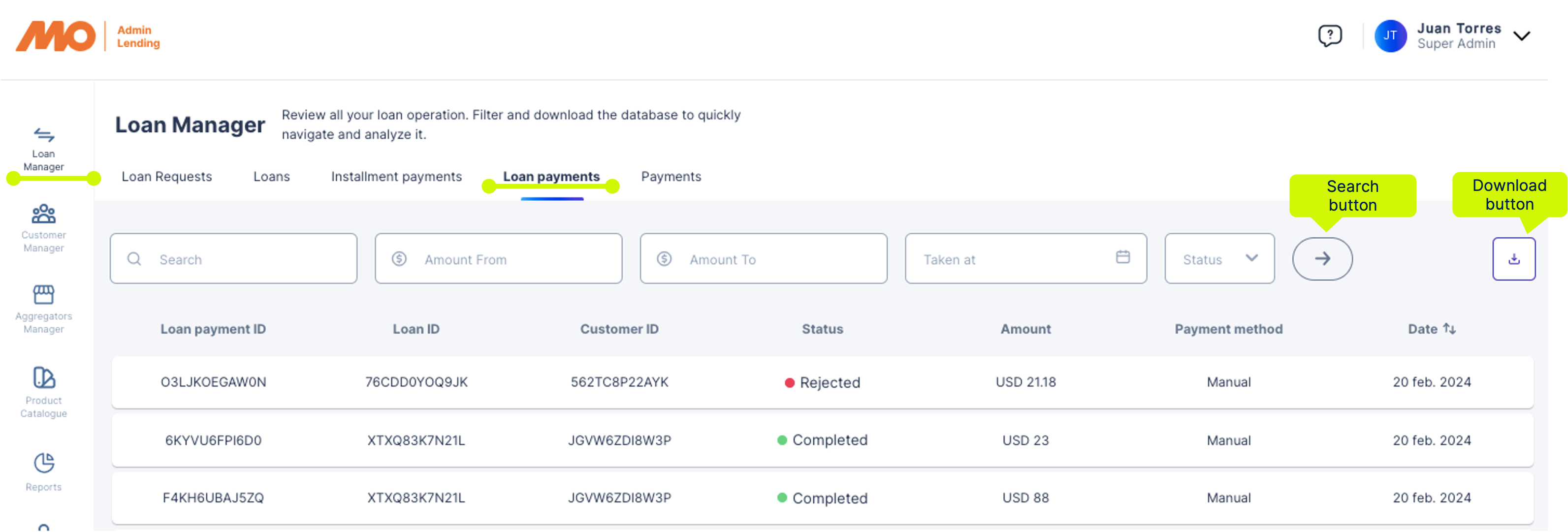
At the top you will find some filters that will allow you to make a better search.
- Search filter: enter a customer ID to find your information in the list, Loan ID or Loan payment ID.
- Amount from-to filter: enter a minimum and/or maximum amount to find all transactions belonging to this range.
- Filter Taken at: select a specific date or time period (days, weeks or months) to find the requests made on these dates. The filter has a drop-down to facilitate the search.
- Status Filter: Filter by the status of the prepayment.
The user can use one or more filters at a time. Once you have selected the filters you wish to work with, click on the "Search" button to start the search.
The Taken at: filter has a drop-down to facilitate the search. Select the period you wish to search (manually in the calendar or via the preset options on the left), then click the "Set Date" button to select the date.
The Status filter also has a drop-down. Click on the right arrow to display the status options and select the one you wish to search for. Completed, Pending, Rejected.
The download button will allow you to download the information reflected in the list in CSV format. If there are active filters at the time of downloading, only the information corresponding to the active filters will be downloaded.

Download button
List fields:

The fields with arrows on the side allow you to organize the information in ascending or descending order.
- Loan payment ID: Unique identifier for a payment.
- Loan ID: Unique identifier for a loan.
- Customer: Unique identifier for a user who completed the onboarding process.
- Status: Status of the payment.
- Amount: Amount paid.
- Payment method: Method in which the payment was made (automatic or manual).
- Date: Date on which the payment was made.
Payments
In the Payments section, you will find the total number of payments made to date, if the client decided to pay all his debt (several loans in one transaction), the total will be shown in this section and how they were distributed across the loans.
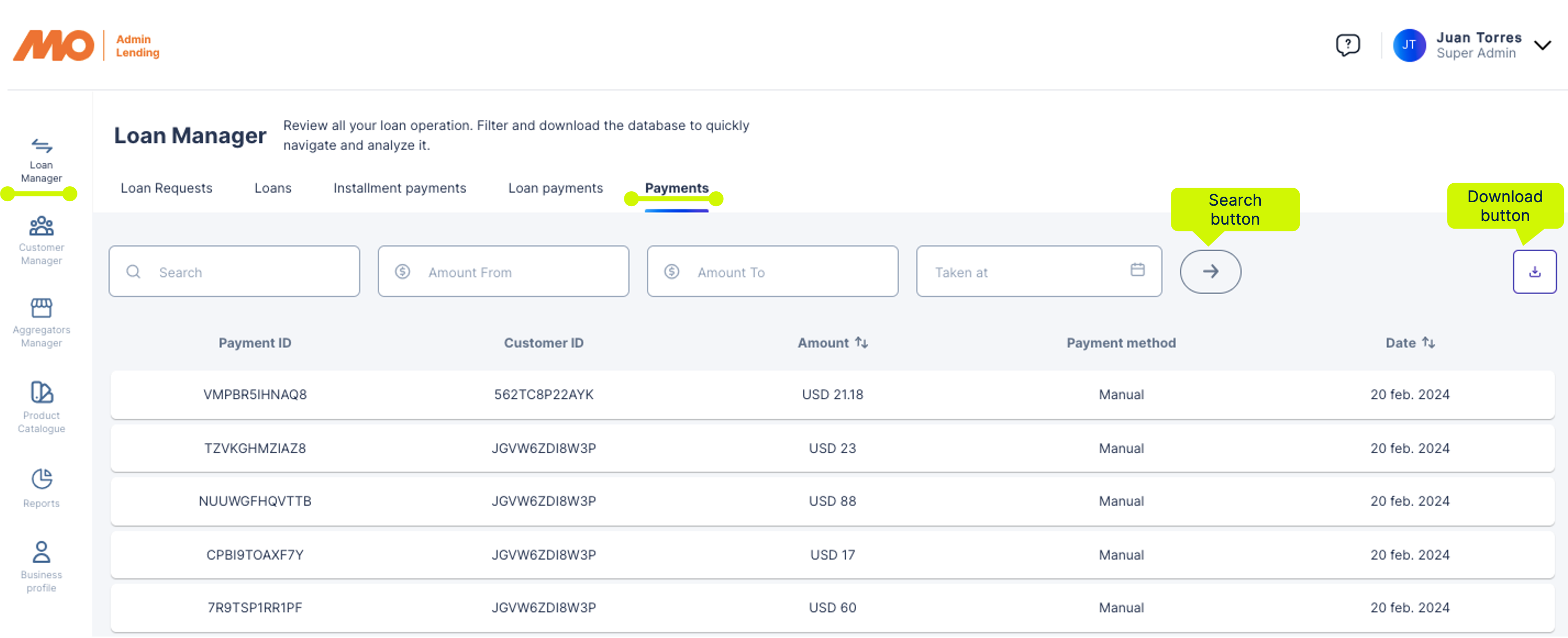
At the top you will find some filters that will allow you to make a better search.
- Search filter: enter the customer ID to find your information in the list.
- Amount from-to filter: enter a minimum and/or maximum amount to find all transactions within this range.
- Filter Taken at: select a specific date or period (days, weeks or months) to find the requests made on these dates. The filter has a drop-down to facilitate the search.
The user can make use of one or more filters at a time. Once you have selected the filters you want to work with, click on the "Search" button to start the search.
The Taken at filter has a drop-down to facilitate the search. Select the period you wish to search (manually in the calendar or by using the preset options on the left), then click on the "Set Date" button to select the date.
The download button will allow you to download the information reflected in the list in CSV format. If there are active filters at the time of downloading, only the information corresponding to the active filters will be downloaded.

Download button
The fields that make up the list are: Payment ID, Credit ID, Customer ID, Payment Status, Payment Amount, Payment Type, Payment Date. On the right side of the "Amount" and "Type" fields you can find two arrows, which allow you to arrange the information in ascending or descending order.
List fields:

The fields with arrows on the side allow you to organize the information in ascending or descending order.
- Payment ID: Unique payment identifier
- Customer ID: Unique identifier for a customer who completed the onboarding process.
- Amount: Amount paid
- Payment method: How payment was made (Automatic or manual)
- Date: Date on which payment was made
Updated 24 days ago
